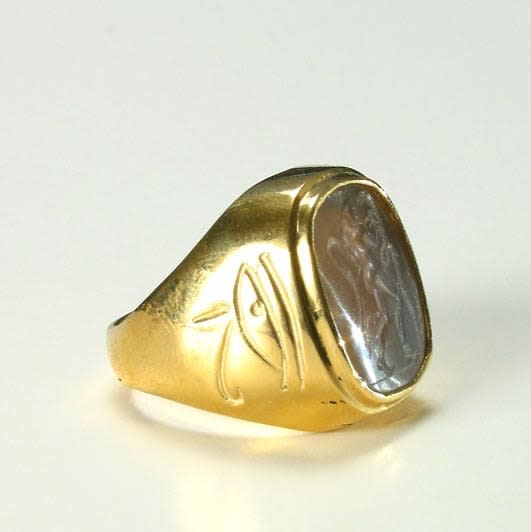Gold Ring Featuring a Roman Agate Intaglio of a Deity Battling Serpents, 100 CE - 300 CE
Agate and Gold
FJ.6673
Further images
This Ancient Seal Has Been Set in a Modern 18 Karat Gold Rin The art of glyptics, or carving images on colored precious stones, is probably one of the oldest...
This Ancient Seal Has Been Set in a Modern 18 Karat Gold Rin
The art of glyptics, or carving images on colored precious stones, is probably one of the oldest known to humanity. Intaglios, gems with an incised design, were made as early as the fourth and third millennia B.C. in Mesopotamia and the Aegean Islands. They exhibit a virtuosity of execution that suggests an old and stable tradition rooted in the earliest centuries. The tools required for carving gems were simple: a wheel with a belt-drive and a set of drills. Abrasives were necessary since the minerals used were too hard for a metal edge. A special difficulty of engraving intaglios, aside from their miniature size, was that the master had to work with a mirror-image in mind.
An image of a god wrestling two serpents has been carved onto the polished surface of this precious gemstone. Perhaps this scene is symbolic of a greater struggle pitting the civilized Roman Empire against the barbarians as represented by the serpents. Perhaps this scene depicts a mythological event similar to the famous Lacoon group. While our interpretations of this image may be somewhat lacking, we can fully appreciate this intaglio for its stunning beauty. The level of detail and clarity is stunning considering the limited proportions of the polished surface of the gemstone and the difficulty carving such dense, hard material. Today set in a marvelous 18 Karat gold ring, this gorgeous piece of jewelry invokes the glories of Ancient Rome. Wearing this ring reveals a love for the past and for the timeless beauty of the Classics.
The art of glyptics, or carving images on colored precious stones, is probably one of the oldest known to humanity. Intaglios, gems with an incised design, were made as early as the fourth and third millennia B.C. in Mesopotamia and the Aegean Islands. They exhibit a virtuosity of execution that suggests an old and stable tradition rooted in the earliest centuries. The tools required for carving gems were simple: a wheel with a belt-drive and a set of drills. Abrasives were necessary since the minerals used were too hard for a metal edge. A special difficulty of engraving intaglios, aside from their miniature size, was that the master had to work with a mirror-image in mind.
An image of a god wrestling two serpents has been carved onto the polished surface of this precious gemstone. Perhaps this scene is symbolic of a greater struggle pitting the civilized Roman Empire against the barbarians as represented by the serpents. Perhaps this scene depicts a mythological event similar to the famous Lacoon group. While our interpretations of this image may be somewhat lacking, we can fully appreciate this intaglio for its stunning beauty. The level of detail and clarity is stunning considering the limited proportions of the polished surface of the gemstone and the difficulty carving such dense, hard material. Today set in a marvelous 18 Karat gold ring, this gorgeous piece of jewelry invokes the glories of Ancient Rome. Wearing this ring reveals a love for the past and for the timeless beauty of the Classics.





